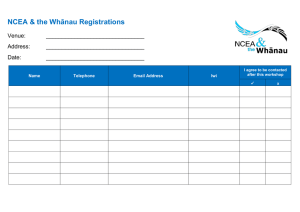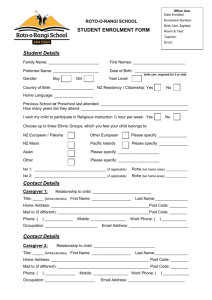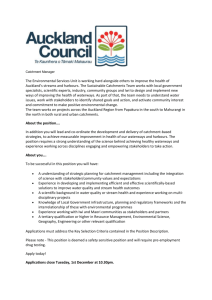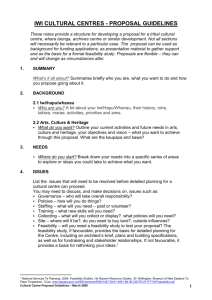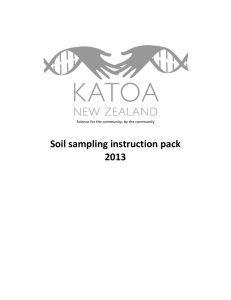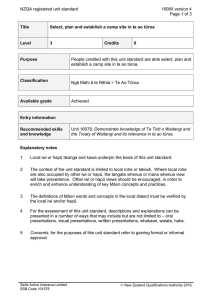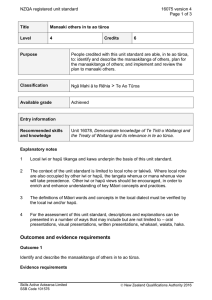Water Allocation Development A4.indd
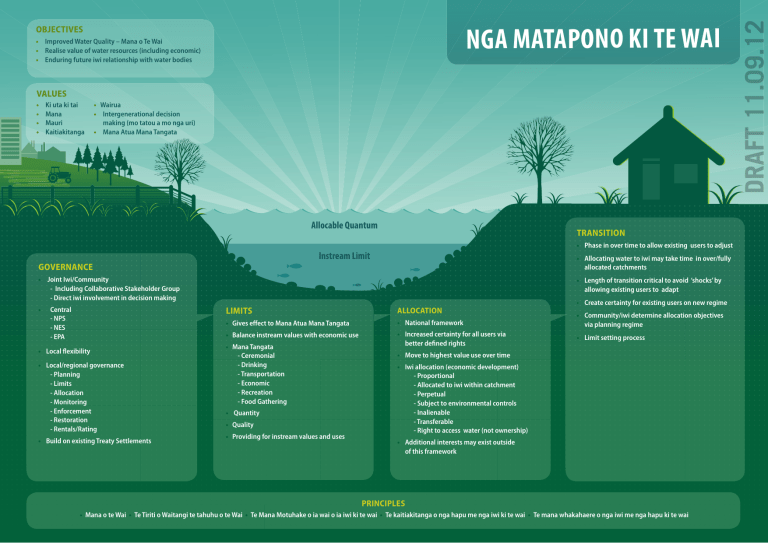
OBJECTIVES
• Improved Water Quality – Mana o Te Wai
• Realise value of water resources (including economic)
• Enduring future iwi relationship with water bodies
VALUES
• Ki uta ki tai
• Mana
• Mauri
• Kaitiakitanga
• Wairua
• Intergenerational decision
making (mo tatou a mo nga uri)
• Mana Atua Mana Tangata
NGA MATAPONO KI TE WAI
GOVERNANCE
• Joint Iwi/Community
- Including Collaborative Stakeholder Group
- Direct iwi involvement in decision making
• Central
- NPS
- NES
- EPA
• Local fl exibility
• Local/regional governance
- Planning
- Limits
- Allocation
- Monitoring
- Enforcement
- Restoration
- Rentals/Rating
• Build on existing Treaty Settlements
Allocable Quantum
Instream Limit
LIMITS
• Gives effect to Mana Atua Mana Tangata
• Balance instream values with economic use
• Mana Tangata
- Ceremonial
- Drinking
- Transportation
- Economic
- Recreation
- Food Gathering
• Quantity
• Quality
• Providing for instream values and uses
ALLOCATION
• National framework
• Increased certainty for all users via
better defi ned rights
• Move to highest value use over time
• Iwi allocation (economic development)
- Proportional
- Allocated to iwi within catchment
- Perpetual
- Subject to environmental controls
- Inalienable
- Transferable
- Right to access water (not ownership)
• Additional interests may exist outside
of this framework
TRANSITION
• Phase in over time to allow existing users to adjust
• Allocating water to iwi may take time in over/fully
allocated catchments
• Length of transition critical to avoid ‘shocks’ by
allowing existing users to adapt
• Create certainty for existing users on new regime
• Community/iwi determine allocation objectives
via planning regime
• Limit setting process
PRINCIPLES
• Mana o te Wai • Te Tiriti o Waitangi te tahuhu o te Wai • Te Mana Motuhake o ia wai o ia iwi ki te wai • Te kaitiakitanga o nga hapu me nga iwi ki te wai • Te mana whakahaere o nga iwi me nga hapu ki te wai
OBJECTIVES
• Improving and maintaining water quality – te mana o te wai – is a fi rst order
objective for iwi and all New Zealanders
• Water is a valuable resource and has the potential to deliver signifi cant benefi ts
including economic benefi ts, for iwi and the community, o Maximising the value of water (including social, economic, cultural and
environmental benefi ts) for the community, including government, iwi,
and all users, will require better defi nition of the bundle of rights attached
to water o This requires recognising iwi rights and interests through:
• providing for iwi in governance and decision making roles
• recognising iwi values in the decision making framework and
• providing iwi with an equitable allocation of water quantity and quality.
• Iwi want to re-establish and maintain an enduring relationship with their
ancestral/ traditional water-bodies – mana whakahaere – recognising both
their inherent mana and associated kaitiaki responsibilities over these water
bodies. This includes being able to share equitably in any development capacity
associated with a water body (allocable quantum).
GOVERNANCE
• Providing iwi with a direct role in the governance and decision-making
processes for fresh water is crucial to recognising and providing for iwi rights
and interests.
• ILG support the recommendations in LAWF report regarding collaborative
decision making but need to also go further and ensure iwi sit at decision
making table at all levels
• Iwi must be involved in both central government decision-making (e.g. NPS,
NES, EPA) and regional/local government.
• This will require fl exibility to meet regional/local circumstances and fresh
thinking regarding local government structures
• Existing Treaty settlement framework tools are inadequate (joint advisory
committees, advisory boards)
• Existing settlement mechanisms may provide a starting point where
appropriate but can be enhanced and developed further
• Enduring structures will need to develop over time as capacity and capability
develop
ALLOCATION
• Allocating water to both consumptive and non-consumptive uses is central to
eff ectively managing water and realizing the highest possible value
from the resource
• Increasing certainty to all water users via more defi ned rights is an important
factor in maximizing the value of water
• Enabling water to fl ow to highest and best use (e.g. transfers)
• Recognising iwi rights and interests through an equitable allocation of allocable
quantum
• Allocation to iwi who uphold mana in catchment
• National Framework for allocation
• Characteristics of ‘iwi allocation’ o Proportional o Perpetual o Transferable o Inalienable o Subject to standard environmental controls o Right to access water (not ownership of water)
• Proptional allocation of allocable quantum within a catchment – equitable
allocation does not mean all iwi will receive same quantity of water
• Iwi allocation recognises residual iwi rights and interests in water common to all
iwi. Some iwi may be able to claim/prove additional rights and interests depending
on particular situations (e.g. Poroti Springs)
TRANSITIONAL PHASE
• Shifting from the current regime to a new regime with more clearly defi ned
rights including recognition and provision for iwi rights and interests will require
a transitional phase to ensure existing water users andrights holders are not
unfairly prejudiced
• Ensuring a ‘soft landing’ for existing users into new regime will be important
• Where unallocated water is available within a catchment this could be directly
allocated to iwi
• Where catchments are fully or over-allocated accessing available water for
allocation to iwi may take some time. This timeframe may need to be
negotiated on a case by case basis (possibly within a national framework?).
• Decisions will be required on how existing rights holders should be transitioned
into new regime, e.g. o Grandfathering o Re-allocation on expiry o Recognition of existing investment o How to manage re-allocation to iwi
• Transitional limits required in interim until governance arrangements can
establish regional/local limits.
VALUES
• Recognising the values of iwi in the decision-making framework is
an important aspect of the iwi connection with
their water bodies.
• While these may vary iwi to iwi, recognising a set of common iwi
values within the decision-making framework is central to
establishing the enduring connection between iwi and their water-bodies.
• Mana Atua
- Mauri
- Wairua
- Natural character
- Mana
- Life supporting
- Ecology
- Biodiversity
- Native fi sh
• Mana Tangata
- Ceremonial
- Drinking
- Transportation
- Economic
- Recreation
- Food Gathering
• These values include: o Intergenerational decision making o Ki uta ki tai, mountains to the sea integrated land and water
management across the whole catchment o Mana (both of the water, and iwi exercising mana over it) o Mauri (protecting the inherent life supporting capacity of the wai) o Kaitiakitanga o Wairua
LIMIT SETTING
• A robust planning regime, including enforceable limits is central to achieving the
stated objectives for water management reforms
• Limits are required for both water quality and water quantity
• Enforcing limits will require transitioning to the new regime, particularly in
catchments requiring improvements in water quality or where water is
over-allocated
• Balance between protecting in-stream values and maximizing the economic value
of the allocable quantum – iwi working with wider community to establish a
balance via governance mechanisms
• Range of values (including economic e.g. tourism) provided through in-stream
values
